BMW Z4 Roadster 3 0I 2004, Z4 2 5I 2004, 3 0I Roadster Coupe 2004 Owner's Manual
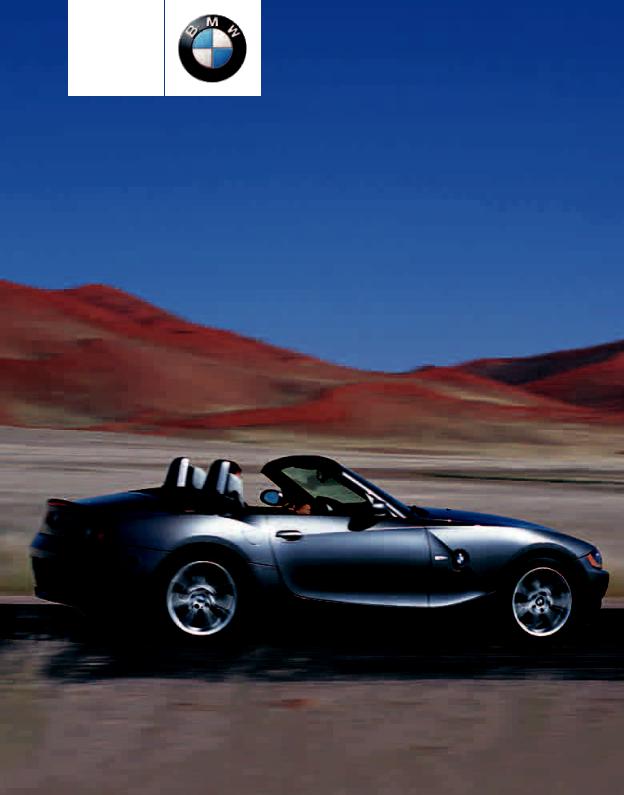
Owner's Manual for Vehicle
Contents
A-Z
Online Version for Part No. 01 41 0 157 498 - © 10/03 BMW AG
Online Version for Part No. 01 41 0 157 498 - © 10/03 BMW AG

Z4 2.5i
Z4 3.0i
Congratulations, and thank you for choosing a BMW.
Thorough familiarity with your vehicle will provide you with enhanced control and security when you drive it. Therefore, we have one request:
Please take the time to read this Owner's Manual and familiarize yourself with the information that we have compiled for you before starting off in your new BMW. The manual contains important data and instructions intended to assist you in obtaining maximum satisfaction from your BMW's unique array of advanced technical features. It also contains information on vehicle maintenance designed to enhance operating safety while simultaneously helping you to maintain your BMW's value throughout an extended service life. For additional information refer to the supplemental manuals.
This Owner's Manual should be considered a permanent part of this vehicle. It should stay with the vehicle when sold to provide the next owner with important operating, safety and maintenance information.
We wish you an enjoyable driving experience.
BMW AG
Online Version for Part No. 01 41 0 157 498 - © 10/03 BMW AG
© 2003 Bayerische Motoren Werke Aktiengesellschaft
Munich, Germany
Reprinting, including excerpts, only with the written consent of BMW AG, Munich. Order No. 01 41 0 157 498
US English IX/03 Printed in Germany
Printed on environmentally friendly paper, bleached without chlorine, suitable for recycling.
Online Version for Part No. 01 41 0 157 498 - © 10/03 BMW AG

Contents
The fastest way to find information on special topics is by using the index, refer to page 104.
Using this Owner's Manual
4 |
Notes |
7 |
Reporting safety defects |
At a glance
10 Cockpit
Controls
16 Opening and closing
27 Adjustments
33 Transporting children safely
36 Driving
46 Lamps
48 Everything under control
52Technology for safety and driving convenience
58Controlling the climate for pleasant driving
64 Interior conveniences
Driving tips
68 Special operating instructions
Mobility
74Refueling
75Wheels and tires
81 In the engine compartment
86Maintenance
87Laws and regulations
88Replacement procedures
93 Giving and receiving assistance
Reference
100 Technical data
104 Everything from A to Z
Online Version for Part No. 01 41 0 157 498 - © 10/03 BMW AG
At a glance
Controls
Driving tips
Mobility
Reference

Notes
Notes
About this Owner's Manual
We have made every effort to ensure that you are able to find what you need in this Owner's Manual as quickly as possible.
The fastest way to find certain topics is by using the detailed index at the end. If you wish to gain an initial overview of your vehicle, you will find what you are looking for in the first chapter.
Should you wish to sell your BMW at some time in the future, please remember to pass the Owner's Manual on to the new owner. The manual represents an important component of the vehicle.
Additional sources of information
If you have additional questions, your BMW center will be glad to advise you.
You can find more information about BMW, for example on its technology, on the Internet under www.bmw.com.
Symbols used
Indicates precautions that must be followed precisely in order to avoid the possibility of personal injury and seri-
ous damage to the vehicle.
Contains information that will assist you in gaining the optimum benefit from your vehicle and enable you to care
more effectively for your vehicle.
Refers to measures that can be taken to help protect the environment.
< Marks the end of a specific item of information.
* Indicates special equipment, countryspecific equipment and optional extras when available.
Vehicle Memory, Key Memory, refer to page 31. Identifies functions that can be specifically adapted for a particular
key or vehicle. These adjustments can be performed either by yourself or by your BMW center.
Symbol on vehicle parts
Indicates that you should consult the relevant section of this Owner's Man-
ual for information on a particular part or assembly.
4
Online Version for Part No. 01 41 0 157 498 - © 10/03 BMW AG

Your individual vehicle
On buying your BMW, you have decided in favor of a model with individualized equipment and features. This Owner's Manual describes all models and equipment that BMW offers within the same group.
We hope you will understand that equipment and features are included which you might not have chosen for your vehicle. Any differences can easily be identified since all optional accessories and special equipment are marked with an asterisk *.
If your BMW features equipment not described in this Owner's Manual, for example a car radio or telephone, supplementary Owner's Manuals are enclosed. We ask that you read these manuals as well.
Status of the Owner's
Manual
BMW pursues a policy of continuous, ongoing development that is conceived to ensure that our vehicles continue to embody the highest quality and safety standards combined with advanced, state- of-the-art technology. For this reason, the features described in this Owner's Manual could differ from those on your vehicle. Nor can errors and omissions be entirely ruled out. You are therefore asked to appreciate that no claims can be entertained on the basis of the data, illustrations or descriptions in this manual.
For your own safety
Fuels
Use unleaded gasoline only. Fuels containing up to and including 10%
ethanol or other oxygenates with up to 2.8% oxygen by weight, i.e. 15% MTBE or 3% methanol plus an equivalent amount of co-solvent, will not void the applicable warranties respecting defects in materials or workmanship. Field experience has indicated significant differences in fuel quality, i.e. volatility, composition, additives, etc., among gasolines offered for sale in the United States and Canada. The use of poor quality fuels may result in driveability, starting and stalling problems especially under certain environmental conditions, such as high ambient temperature and high altitude.
Should you encounter driveability problems that you suspect could be related to the fuel you are using, we recommend that you respond by switching to a recognized high-quality brand.
Failure to comply with these recommendations may result in unscheduled maintenance.
Follow the relevant safety rules when you are handling gasoline.<
Maintenance and repair
Advanced technology, e.g. the use of modern materials and high-perfor-
mance electronics, requires specially adapted maintenance and repair methods. Therefore, only have corresponding work on your BMW carried out by a BMW center or a workshop that works according to BMW repair procedures with correspondingly trained personnel. If work is carried out improperly there is a danger of consequential damage and the related safety risks.<
5
Online Version for Part No. 01 41 0 157 498 - © 10/03 BMW AG
At a glance
Controls
Driving tips
Mobility
Reference

Notes
Parts and accessories
For your own safety, use parts and accessories approved by BMW.
When you purchase accessories tested and approved by BMW and Original BMW Parts, you simultaneously acquire the assurance that they have been thoroughly tested by BMW to ensure optimum performance when installed on your vehicle. BMW warrants these parts to be free from defects in material and workmanship. BMW will not accept any liability for damage resulting from installation of parts and accessories not approved by BMW.
BMW cannot test every product made by other manufacturers to verify if it can be used on a BMW safely and without risk to either the vehicle, its operation, or its occupants.
Original BMW Parts, BMW Accessories and other products approved by BMW, together with professional advice on using these items, are available from all BMW retailers.
Installation and operation of non-BMW approved accessories such as alarms, radios, amplifiers, radar detectors, wheels, suspension components, brake dust shields, telephones, including operation of any portable cellular phone from within the vehicle without using an externally mounted antenna, or transceiver equipment, e.g. C.B., walkie-talkie, ham radio or similar, may cause extensive damage to the vehicle, compromise its safety, interfere with the vehicle's electrical system or affect the validity of the BMW Limited Warranty. See your BMW center for additional information.
Do not use key or remote control to lock doors or trunk with anyone inside the vehicle. Refer to the Owner's Manual for more details.<
Maintenance, replacement or repair of the emission control devices and
systems may be performed by any automotive repair establishment or individual using any certified automotive part.<
Service and warranty
This manual is supplemented by a Service and Warranty Information Booklet for US models, Warranty and Service Guide Booklet for Canadian models.
We recommend that you read this publication thoroughly.
Your BMW is covered by the following warranties:
>New Vehicle Limited Warranty
>Rust Perforation Limited Warranty
>Federal Emissions System Defect Warranty
>Federal Emissions Performance Warranty
>California Emission Control System Limited Warranty.
Detailed information about these warranties is listed in the Service and Warranty Information Booklet for US models, Warranty and Service Guide Booklet for Canadian models.
6
Online Version for Part No. 01 41 0 157 498 - © 10/03 BMW AG

Reporting safety defects
The following only applies to vehicles owned and operated in the US.
If you believe that your vehicle has a defect which could cause a crash or could cause injury or death, you should immediately inform the National Highway Traffic Safety Administration NHTSA in addition to notifying BMW of North America, LLC, P.O. Box 1227, Westwood, New
Jersey 07675-1227, telephone toll-free 1-800-831-1117.
If NHTSA receives similar complaints, it may open an investigation, and if it finds that a safety defect exists in a group of vehicles, it may order a recall and remedy campaign. However, NHTSA cannot become involved in individual problems between you, your retailer, or BMW of North America, LLC.
To contact NHTSA, you may either call the Auto Safety Hotline toll-free at 1-800-424-9393 or 366-0123
in Washington, D.C. area, or write to: NHTSA, U.S. Department of Transportation, Washington, D.C. 20590. You can also obtain other information about motor vehicle safety from the Hotline.
7
Online Version for Part No. 01 41 0 157 498 - © 10/03 BMW AG
At a glance
Controls
Driving tips
Mobility
Reference
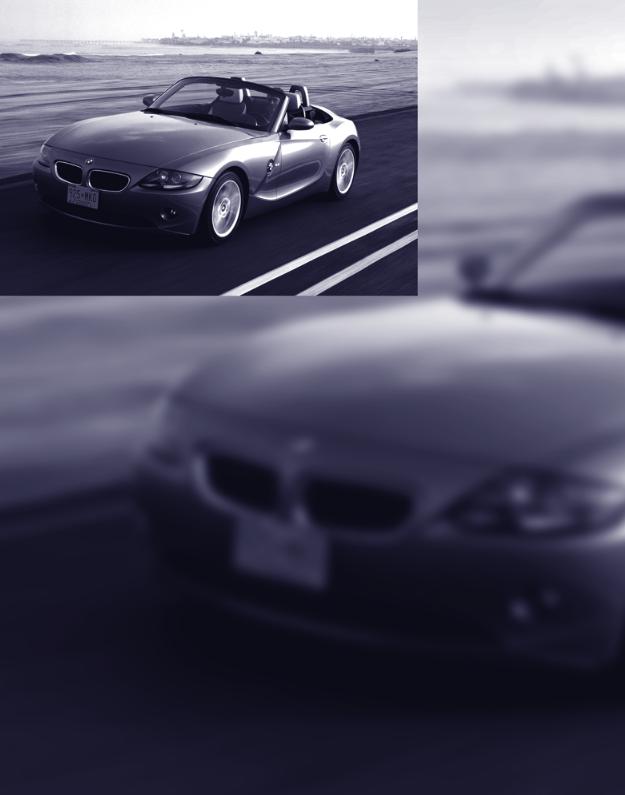
Online Version for Part No. 01 41 0 157 498 - © 10/03 BMW AG
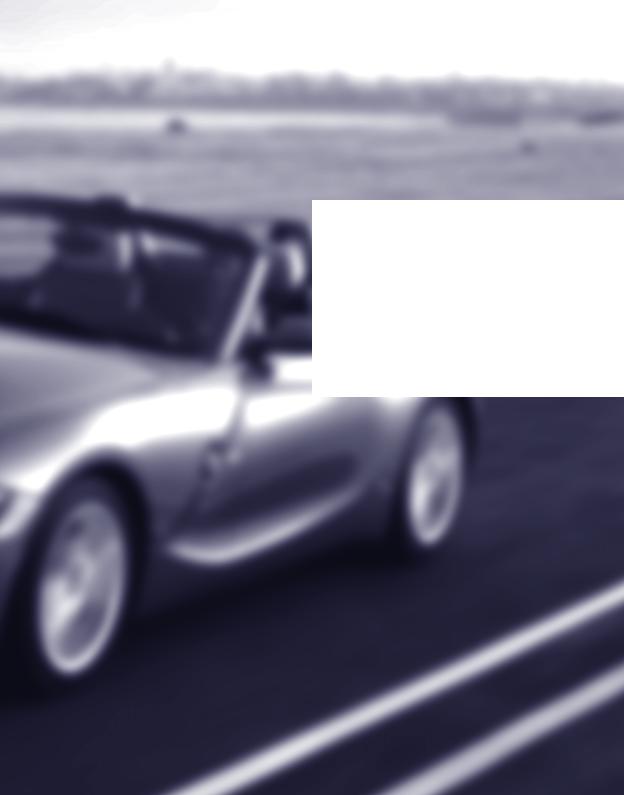
At a glance
The overviews of buttons, switches and displays presented in this chapter will help you find your way around your vehicle. You will also be familiarized with the concepts behind the operation of the features available to you.
Online Version for Part No. 01 41 0 157 498 - © 10/03 BMW AG
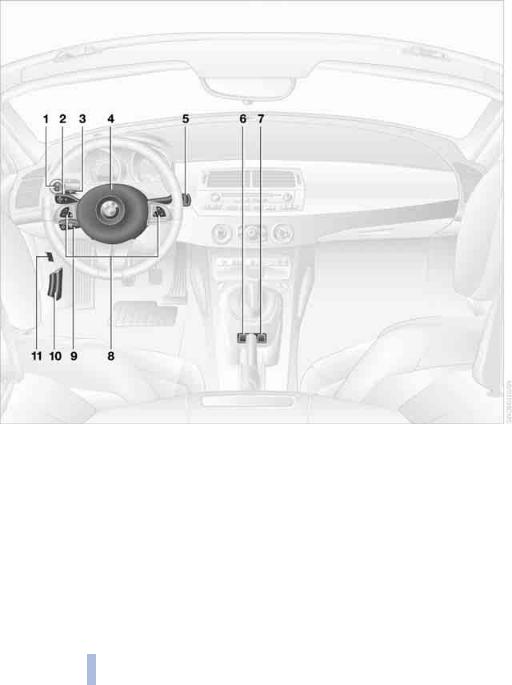
Cockpit
Cockpit
Control elements
1 |
Parking lamps/Low beams 46 |
3 |
Fog lamps 47 |
2 |
> Turn signal indicators 43 |
4 |
Horn |
|
> Standing lamps 47 |
5 |
Washer/wiper system/Rain sensor 43 |
|
> High beams 47 |
6 |
Hazard warning flashers |
|
> Headlamp flasher 43 |
7 |
Central locking system 18 |
|
> Computer 50 |
|
|
10
Online Version for Part No. 01 41 0 157 498 - © 10/03 BMW AG

8 Buttons in steering wheel*
Volume
Press briefly:
Accept incoming call, start dialing, terminate call
Extended pressure:
Activate and deactivate voice entry
Switch between telephone and radio or CD
Fast forward/rewind
>Radio
Press briefly: next station in station memory
Extended pressure: station search
>CD
Press briefly: jump to next track Extended pressure: fast forward/rewind
>Telephone
Scan personal phone book
9Cruise control 45
10Hood release 81
11Luggage compartment lid release 19
11
Online Version for Part No. 01 41 0 157 498 - © 10/03 BMW AG
At a glance
Controls
Driving tips
Mobility
Reference

Cockpit
Instrument cluster
1 |
Speedometer |
|
|
Indicator and warning |
2 |
Indicator and warning lamps 12 |
|
lamps |
|
3 |
Tachometer 48 |
|
|
Technology that monitors itself |
|
with indicator and warning lamps |
12 |
||
4 |
Engine coolant temperature gauge |
48 |
Indicator and warning lamps that are iden- |
|
5 |
Fuel gauge 48 |
|
|
tified by + are tested for proper functioning |
|
|
whenever the ignition key is turned. They |
||
6 |
Button for |
|
|
|
|
|
each light up once for different periods of |
||
|
> Time 49 |
|
|
|
|
|
|
time. |
|
|
> Service interval display |
49 |
|
If a fault should occur in one of these sys- |
7 |
Display field for selector lever and pro- |
tems, the corresponding lamp does not go |
||
|
gram indicator |
|
|
out after the engine is started or it lights up |
|
> Automatic transmission |
39 |
|
again while the vehicle is moving. The indi- |
|
|
cated pages provide information on what |
||
|
|
|
|
|
> Sequential manual gearbox |
measures to take. |
|
SMG 42 |
||
|
8Button for
>Trip odometer, reset to zero 48
>Setting time 49
9Display for
>Trip odometer/Odometer 48
>Clock 49
>Service interval 49
>Computer 49
12
Online Version for Part No. 01 41 0 157 498 - © 10/03 BMW AG
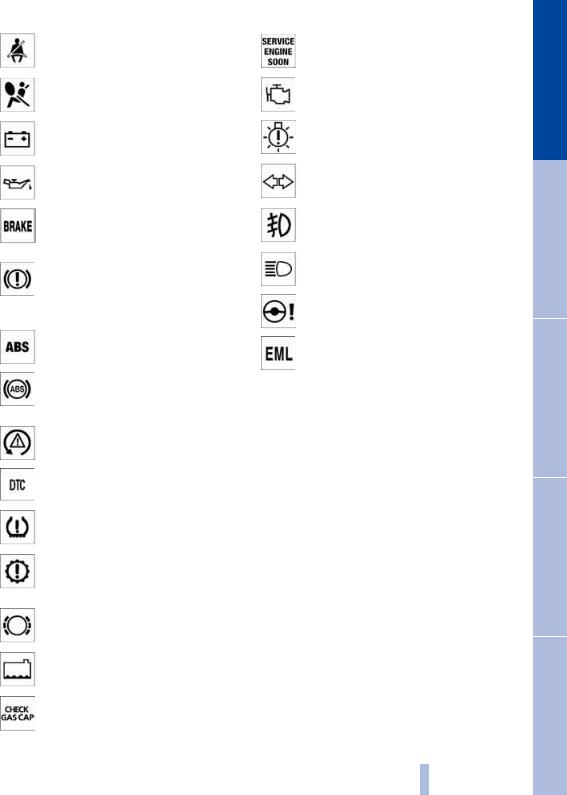
Please fasten safety belts + 30
Airbags + 56
Battery charge current+ 91
Engine oil pressure/Engine oil level/Engine oil sensor + 83
Service Engine Soon + 87
Service Engine Soon warning lamp for Canadian models + 87
Defective bulbs 46
Turn signal indicators 43
Parking brake/Chassis control sys- |
Fog lamps 47 |
|
tems/Dynamic Brake Control/ |
|
|
Brake fluid + 38/ 52/ 53/ 85 |
|
|
Parking brake/Chassis control sys- |
Headlamp flasher/ |
|
High beams 43/ 47 |
||
tems/Dynamic Brake Control/ |
||
|
||
Brake fluid for Canadian models |
Electric Power Steering EPS + 43 |
|
+ 38/ 52/ 53/ 85 |
||
|
||
Antilock Brake System ABS/Chas- |
Engine electronics + |
|
sis control systems + 54/ 52 |
||
Engine electronics malfunction. |
||
|
||
Antilock Brake System ABS/Chas- |
You can continue to drive with |
|
reduced engine output or engine |
||
sis control systems for Canadian |
||
speed. Please have the system |
||
models + 54/ 52 |
||
inspected by your BMW center. |
||
|
||
Dynamic Stability Control |
Colors |
|
DSC + 52 |
||
The indicator and warning lamps can light |
||
|
||
Dynamic Traction Control |
up in various colors and combinations. |
|
DTC + 52 |
The following section explains the signifi- |
|
Flat Tire Monitor + 54 |
cance of the individual colors as well as |
|
how you should respond. |
||
|
> Red: |
|
Automatic transmission/ |
Stop the vehicle immediately |
|
or |
||
Sequential manual gearbox |
||
an important reminder |
||
SMG + 40/ 42 |
||
> Red and yellow: |
||
|
||
Brake pads + 70 |
Continue driving cautiously |
|
|
> Yellow: |
|
|
Have the system checked soon |
|
Add coolant 84 |
or |
|
|
for your information |
|
CHECK GAS CAP + 74 |
> Green: |
|
For your information |
||
|
> Blue: |
|
|
For your information. |
|
|
13 |
Online Version for Part No. 01 41 0 157 498 - © 10/03 BMW AG
At a glance
Controls
Driving tips
Mobility
Reference

Online Version for Part No. 01 41 0 157 498 - © 10/03 BMW AG
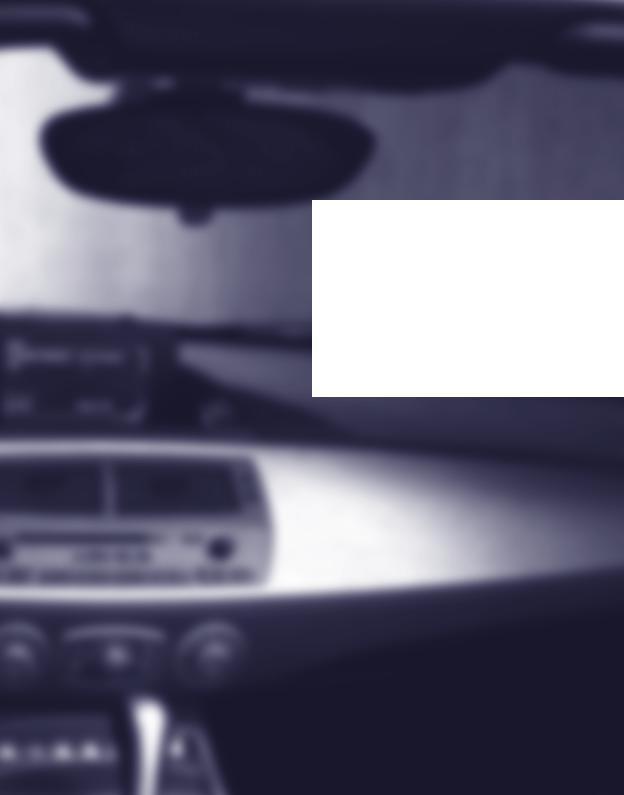
Controls
This chapter provides you with the information you need for complete control over your vehicle. It describes all features used for driving and for ensuring your safety and comfort.
Online Version for Part No. 01 41 0 157 498 - © 10/03 BMW AG
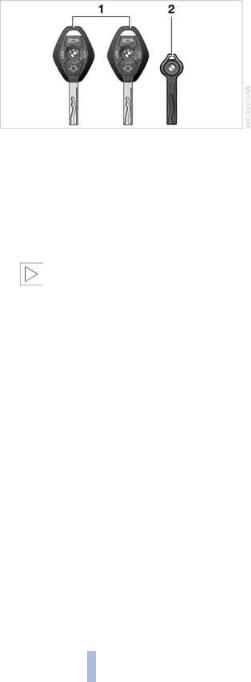
Opening and closing
Opening and closing
Keys
The key set
1Master keys with remote control: they determine the functions of the Key Memory, refer to page 31.
You can mark individual keys for subsequent identification by applying the colored decals that you received when accepting delivery of your vehicle
There is an extended-life battery in every master key that is
charged automatically in the ignition lock as you drive.
For this reason, if you have a master key with remote control that is otherwise not used, use that key approximately once a year while driving for an extended period to charge the battery.<
2Spare key for storage in a safe place, such as in your wallet.
This key does not open the lock of the luggage compartment lid – useful for valet parking, for example.
This key is not intended for constant use
Central locking system
The concept
The central locking system is ready for operation whenever the driver's door is closed. The system simultaneously engages and releases the locks on the
>doors
>luggage compartment lid
>fuel filler door
>storage compartment between the backrests
>opened manual convertible top.
The central locking system can be operated
>from outside using the remote control or via the driver's door lock
>from inside via the central locking system button.
If it is operated from inside, the fuel filler door will not be locked. Refer to page 18.
The anti-theft system is automatically activated whenever you activate the central locking system from outside the vehicle. It prevents the doors from being unlocked with the lock buttons or release handles. The alarm system is also armed.
The central locking system unlocks automatically in the event of an accident. In addition, the hazard warning flashers and interior lamps come on.
Remote control
The concept
The remote control provides two additional functions for central locking.
>Switching on interior lamps, refer to page 17.
With this function, you can also search for the vehicle when parked in an underground garage, for instance
>Opening the luggage compartment lid separately, refer to page 17. It will open slightly, regardless of whether it was locked or unlocked.
Whenever you unlock or lock the vehicle, you simultaneously deactivate/activate the anti-theft system, disarm/arm the alarm
16
Online Version for Part No. 01 41 0 157 498 - © 10/03 BMW AG
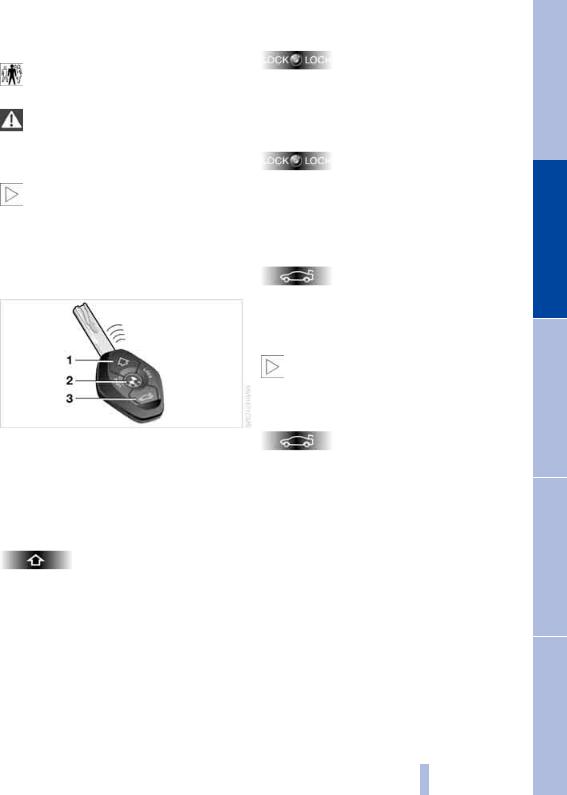
system and switch the interior lamps on/ off.
You can have a signal set to confirm that the vehicle's locks have engaged
securely.<
Since persons or animals in the vehicle could lock the doors from the
inside, always take the vehicle keys with you so that the vehicle can be opened again from the outside at any time.<
If it is no longer possible to lock the vehicle via the remote control, the
battery is discharged. Use this key while driving for an extended period in order to recharge the battery.
In the event of a system malfunction, please contact your BMW center. You can also obtain replacement keys there.<
1To unlock
2To lock and secure, activate interior lamps, disarm tilt alarm sensor and interior motion sensor
3To open the luggage compartment
To switch on the interior lamps
With the vehicle locked:
Press the button.
To deactivate the tilt alarm* and interior motion sensors*
Press the button a second time immediately after locking.
For additional information, refer to page 26.
To open the luggage compartment
Press the button.
The luggage compartment lid will open slightly, regardless of whether it was locked or unlocked.
Before and after a trip, be sure that the luggage compartment lid has not
been opened unintentionally.<
Panic mode*: triggering alarm
By pressing the button for 2 to 5 seconds, the alarm can be sounded in the event of danger. The alarm is turned off by pressing the unlocking button 1 again.
To unlock
1.Press the button to unlock the driver's door and the fuel filler door
2.Press the button a second time to disengage all vehicle locks.
Malfunctions
External systems or devices may cause local interference in the functions of the remote control.
Should this occur, you can still open and close the vehicle using the master key in either the door or luggage compartment locks.
To lock and secure
For US owners only
 The transmitter and receiver units comply Press the button. with part 15 of the FCC, Federal Communi-
The transmitter and receiver units comply Press the button. with part 15 of the FCC, Federal Communi-
cations Commission, regulations. Operation is governed by the following:
17
Online Version for Part No. 01 41 0 157 498 - © 10/03 BMW AG
At a glance
Controls
Driving tips
Mobility
Reference
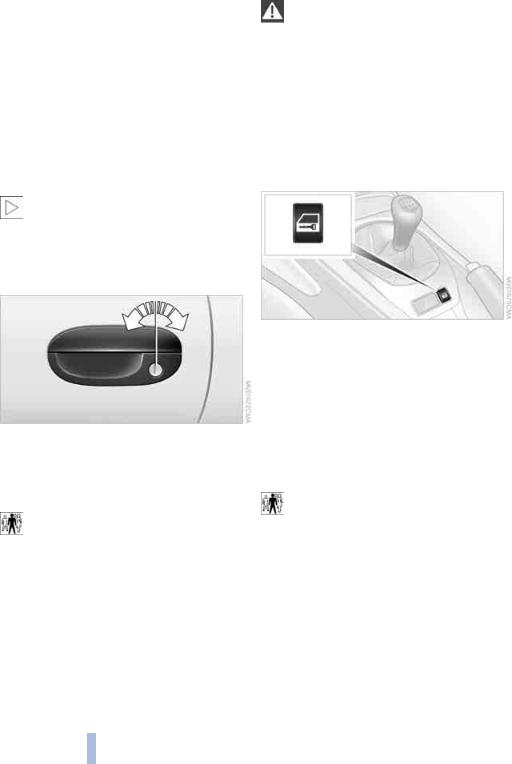
Opening and closing
FCC ID: LX8EWS
LX8FZVS
LX8FZVE
Compliance statement:
This device complies with part 15 of the FCC Rules. Operation is subject to the following two conditions:
>This device may not cause harmful interference, and
>this device must accept any interference received, including interference that may cause undesired operation.
Any unauthorized modifications to these devices could void the user's
authority to operate the equipment.<
Door lock
Watch the closing process carefully and be sure that no one is trapped by
the closing motion. Releasing the key stops the operation.<
Manual operation
In the event of an electrical malfunction
Turn the key all the way to the left or right to unlock/lock the driver's door.
Interior
One turn of the key in the driver's door lock to unlock the driver's door only and the fuel filler door.
Turn the key a second time to disengage all other vehicle locks.
You can have a signal set to confirm that the vehicle's locks have engaged
securely.<
You can use this button to control the central locking system whenever the doors are closed. The doors and luggage compartment lid are unlocked or locked only. The anti-theft system is not activated.
If only the driver's door was unlocked from the outside and you press the button, then, with the driver's door still open, the luggage compartment lid and the fuel filler door will unlock, too. If the driver's door is closed, it will be locked.
If you desire, the central locking system can be activated automatically as
soon as you begin to drive. This can be adjusted to be key-specific.<
Convenience operation |
To unlock and open |
|
> Either unlock the doors together with |
||
You can also operate the power windows |
||
the button for the central locking sys- |
||
and the fully automatic convertible top via |
||
tem and then pull each of the release |
||
the door lock. |
||
handles above the armrests |
||
> To open: |
||
or |
||
With the door closed, hold the key in the |
||
> pull the release handle for each door |
||
Unlock position |
||
> To close: |
twice: the initial pull unlocks the door, |
|
and the second one opens it. |
||
With the door closed, hold the key in the |
||
|
||
Lock position. |
|
18
Online Version for Part No. 01 41 0 157 498 - © 10/03 BMW AG

To lock
>Either use the central locking button to lock both doors at once or
>press the individual door lock buttons down.
To prevent the driver from being inadvertently locked out of the
vehicle, the driver's door lock button will not engage as long as the door is open.<
Since persons or animals in the vehicle could lock the doors from the
inside, always take the vehicle keys with you so that the vehicle can be opened again from the outside at any time.<
To open from inside the vehicle
If the luggage compartment lid has not been locked separately, you can open it with this button in the footwell on the driver's side when the vehicle is stationary.
To close
Luggage compartment lid
To open from the outside
Turn the master key to the left as far as it will go. The luggage compartment lid will open slightly.
If the alarm system is armed, opening the luggage compartment with the key will trigger an alarm; refer also to page 26.
The handle recess in the interior trim panel of the luggage compartment lid makes it easier to pull the lid down.
To avoid injuries, be sure that the travel path of the luggage compart-
ment lid is clear when it is closed, following the same precautions as with all closing procedures.<
Operate the vehicle only when the luggage compartment lid is closed, since exhaust fumes could penetrate into
the interior of the vehicle. Should it be absolutely necessary to operate the vehicle with the luggage compartment lid open and with the convertible top closed:
>Close all windows
>Increase the air supply from the air conditioner or automatic climate control to a high level. Refer to page 58 or 61.<
19
Online Version for Part No. 01 41 0 157 498 - © 10/03 BMW AG
At a glance
Controls
Driving tips
Mobility
Reference
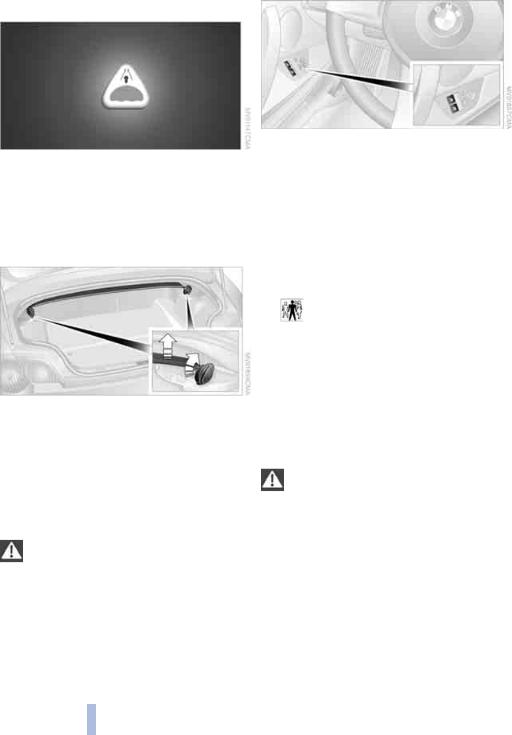
Opening and closing
Luggage compartment |
Electric power windows |
Emergency release
This lever releases the luggage compartment lid from inside the luggage compartment.
To enlarge the luggage compartment
The luggage compartment can be enlarged when the convertible top is closed.
Simultaneously turn the handles on both sides of the luggage compartment outward past the resistance point.
The convertible top compartment panel is raised.
Before opening the convertible top: Turn both handles inward.
The convertible top compartment panel is lowered.
Before opening the convertible top, make sure that the convertible top
compartment panel has been folded down in the luggage compartment to avoid any possible damage.<
To open and close a window
Ignition key in position 1 or higher
>Press the switch until you feel resistance: the window continues to move downward as long as you continue to press the switch
>Press the switch briefly past the pressure point: the window moves downward automatically. Pressing the switch again stops the opening cycle.
If you wish, you can have this special feature activated/deacti-
vated.<
You can close the window in the same manner by pulling the switch.
The window on the passenger side does not move upward automatically.
After the ignition has been switched off: You can still use the electric power windows for up to 15 minutes, as long as no one opens any of the doors.
When leaving the vehicle, always remove the ignition key from the lock
and remember to close the doors to prevent children from operating the power windows and injuring themselves, etc.<
For convenience operation via the door lock, refer to page 18.
20
Online Version for Part No. 01 41 0 157 498 - © 10/03 BMW AG
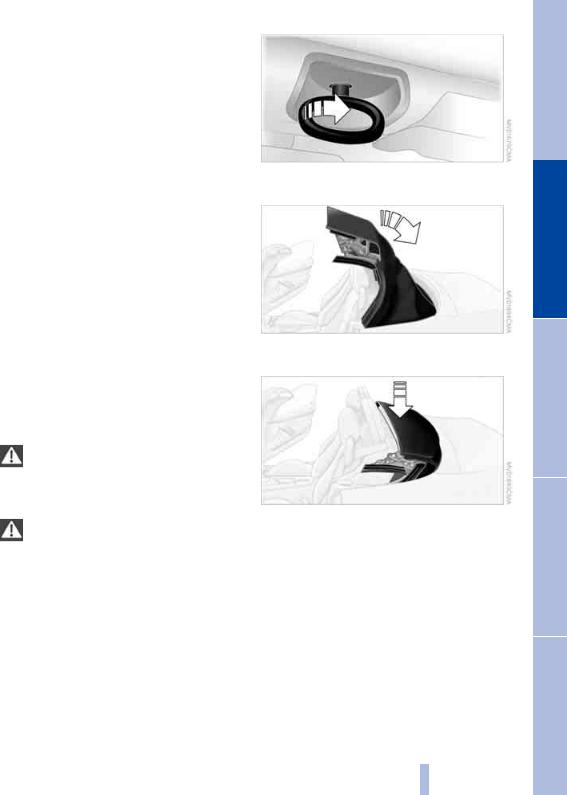
Manual convertible top
The fabric top offers perfect protection against the weather and it can be opened easily and quickly by one person alone.
Here are a few tips so that you get the most out of your BMW:
>It is advisable to close the convertible top when the vehicle is parked.
The closed convertible top not only protects the passenger compartment from unforeseeable damage from the weather, but also provides a certain degree of theft protection
>In addition, only keep valuables in the locked luggage compartment, even with the convertible top closed
>When the convertible top is open, the central locking system also locks the release button for the convertible top. The convertible top cannot be operated. This provides better theft protection for valuables stored in the luggage compartment
>Never mount a roof-mounted luggage rack system on the convertible top.
To open the convertible top
Operate the convertible top only when the vehicle is stationary.
Never store the convertible top for longer than one day while it is wet to avoid permanent damage from moisture.<
Before opening the convertible top, make sure that the convertible top
compartment panel in the luggage compartment is lowered to avoid any possible damage; refer to page 20.<
1.Flip the handle out and turn it to the end stop
2.Open the convertible top and push it toward the rear of the vehicle
3.Gently swing the convertible top downward and press until it engages audibly.
21
Online Version for Part No. 01 41 0 157 498 - © 10/03 BMW AG
At a glance
Controls
Driving tips
Mobility
Reference
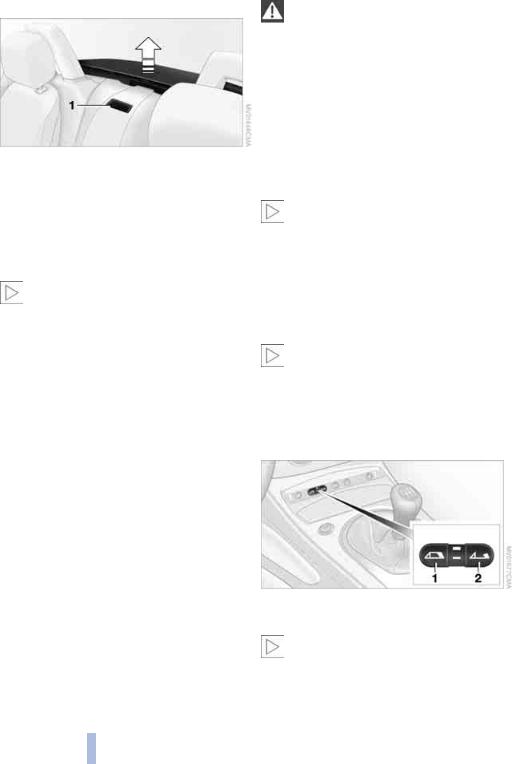
Opening and closing
To close the convertible top
1.Press button 1
The convertible top is released and moves up slightly
2.Holding on to the handle, pull the convertible top forward onto the windshield frame
3.Turn the handle until it audibly engages. The convertible top is locked.
At higher speeds, the passenger compartment may develop relatively
low air pressure, which can cause the convertible top to begin fluttering. Increase the air supply so that low pressure does not occur in the vehicle.<
Fully automatic convertible top*
The fully automatic convertible top combines assured protection against the elements with simple and easy handling.
Here are a few tips so that you get the most out of your BMW:
>It is advisable to close the convertible top when the vehicle is parked. When closed, the top not only guards the passenger compartment from unforeseeable damage from the weather, but also affords a degree of protection against theft. In addition, only keep valuables in the locked luggage compartment, even with the convertible top closed
>Never mount a roof-mounted luggage rack system on the convertible top.
>To prevent damage, do not operate the convertible top at temperatures below 147/–10 6.
Never store the convertible top while it is wet to avoid permanent damage
from moisture.
Driving when the opening or closing process has not been completed can cause vehicle damage or personal injury.
Do not lay objects on the convertible top, since they could fall off when the convertible top is operated and cause damage or injuries.
Do not reach into the convertible top mechanism during opening and closing. Keep children away from the moving parts of the convertible top during operation.<
If possible, only operate the convertible top with the vehicle stopped, as otherwise the process may be interrupted.
If you set the convertible top in motion while the vehicle is stationary and then have to start suddenly, for instance at a traffic light, you can still complete the procedure by driving as slowly as possible and again holding the corresponding button pressed.<
At higher speeds, the passenger compartment may develop relatively
low air pressure, which can cause the convertible top to begin fluttering. Increase the air supply so that low pressure does not occur in the vehicle.<
Opening and closing
1To close
2To open
If at all possible, only operate the convertible top if the engine is running.
This saves unnecessary battery wear. Before closing the convertible top, remove any objects from the windshield frame that
22
Online Version for Part No. 01 41 0 157 498 - © 10/03 BMW AG
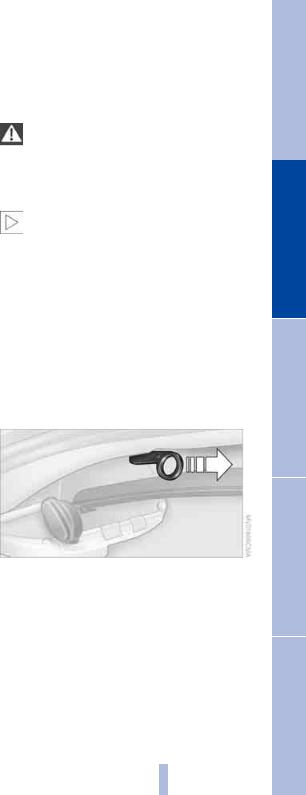
could keep the convertible top from closing properly.<
Ignition key in position 1 or higher. With the vehicle standing.
1.Read and comply with the preceding safety precautions
2.Make sure that the convertible top compartment panel in the luggage compartment is lowered; refer to page 20. Otherwise the convertible top cannot be opened
3.Ensure that the luggage compartment lid is closed
4.Press and hold the corresponding button for convertible top operation.
If the convertible top should halt right before the closing phase is completed, press against the front part of the convertible top frame from the outside to help the closing process along. Keep pressing the button while doing so until the top starts up again on its own.
Indicator lamps
>The red indicator lamp in the button will light up while the convertible top is in motion. It goes out as soon as the opening or closing operation has been completed
>If the red indicator lamp in the button flashes after the button has been released, then the opening or closing operation has not yet been completed. The sequence can be continued in the desired direction by pressing this button
>If the yellow indicator lamp in the button lights up continuously with the button pressed, then the convertible top compartment panel is raised and the convertible top cannot be moved.
The side windows will lower slightly when you press the button for operating the convertible top.
After the opening or closing operation, the side windows will go back up if you keep the button pressed for more than 2 seconds after the indicator lamp has gone out.
Interruption
The automatic sequence will be interrupted immediately if you release the button that operates the top. The sequence can be continued in the desired direction by pressing this button.
If the convertible top operation has been interrupted, do not close the
side windows using the power window buttons. Otherwise the side windows may not close properly against the rubber seal of the convertible top.<
After the convertible top has been stored for an extended period of time
in the convertible top compartment, e.g. in the winter months because the hardtop was being used, you may have to support the convertible top by hand when closing it for the first time.<
Convenience operation
Driver's door lock
Refer to page 18.
To close manually in the event of an electrical malfunction
1.Pull out the handle in the luggage compartment as far as it will go
2.Turn the handle by 90° until it engages
23
Online Version for Part No. 01 41 0 157 498 - © 10/03 BMW AG
At a glance
Controls
Driving tips
Mobility
Reference
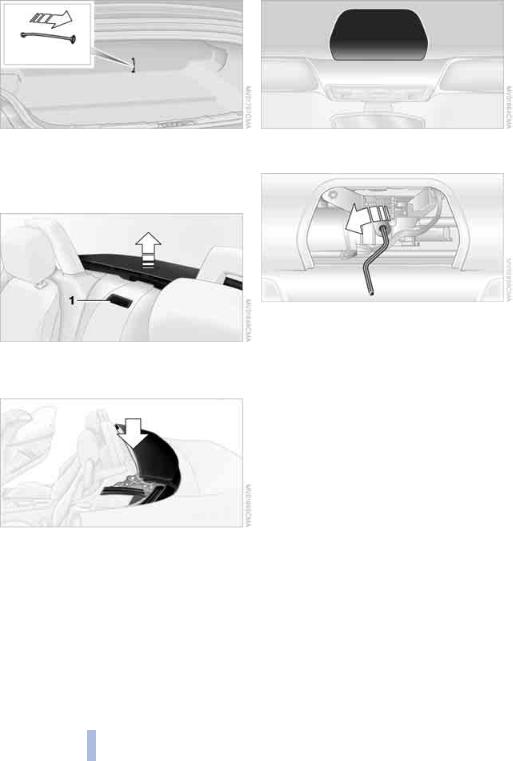
Opening and closing
3.Pull on the cord in the luggage compartment panel
The storage compartment between the backrests unlocks, refer also to
page 64
4.Press button 1
The convertible top is released and moves up slightly
5.Grab the convertible top at its frame and pull it up to the windshield frame
6.Pull out the cover panel that is in the center of the front convertible top frame
7.Insert the Allen wrench into the hex slot. The Allen wrench is located in the vehicle tool pouch, refer to page 88
8.Pull the convertible top frame down as far as possible
9.Continue turning the Allen wrench to the left until the convertible top frame has locked onto the windshield frame.
Wind deflector*
With the convertible top open, the wind deflector keeps air movement in the passenger compartment to a minimum, thus providing you with a pleasant drive, even at higher speeds.
24
Online Version for Part No. 01 41 0 157 498 - © 10/03 BMW AG
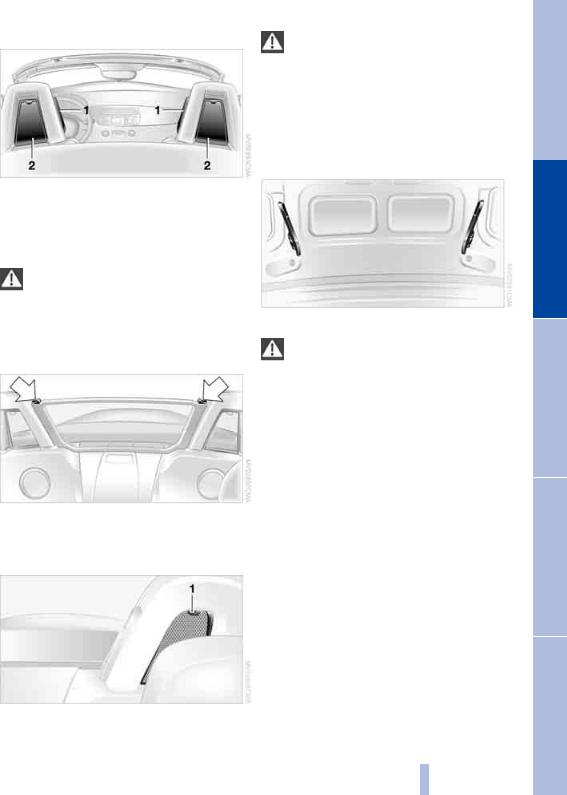
Installation
Insert the wind deflector in its proper orientation into the guides 1 provided on the rollover bars.
Refer to the labeling on the wind deflector to determine its proper orientation.
The wind deflector must engage firmly, as it could otherwise become
detached at higher vehicle speeds.<
The wind deflector panels 2 in the rollover bars cannot be removed.
Removal
Do not hang heavy objects on the hooks. If you do, they could endanger
the passengers, for example during braking or evasive maneuvers.<
Storage
For storage, e.g. to achieve a better view to the rear when the convertible top is closed, there are two brackets on the inside of the luggage compartment lid.
Insert the wind deflector into the brackets.
Make sure that the wind deflector cannot be damaged by objects in the
luggage compartment.<
Slide both locks inward and remove the wind deflector.
Clothes hooks
Clothes hooks 1 are located on the wind deflector panels in the rollover bars.
Alarm system*
The concept
The vehicle alarm system responds:
>When a door, the hood or the luggage compartment lid is opened
>When attempts are made to start the vehicle
>To movement inside the vehicle
>To alterations in the vehicle tilt, e.g. as would occur during attempts to steal the wheels or tow the vehicle
>To interruption of battery voltage.
The alarm produced by the system in the event of unauthorized vehicle entry and attempted theft depends on the country version:
>Sounding of an acoustical alarm for 30 seconds
>Activation of the hazard warning flashers for approx. five minutes.
25
Online Version for Part No. 01 41 0 157 498 - © 10/03 BMW AG
At a glance
Controls
Driving tips
Mobility
Reference
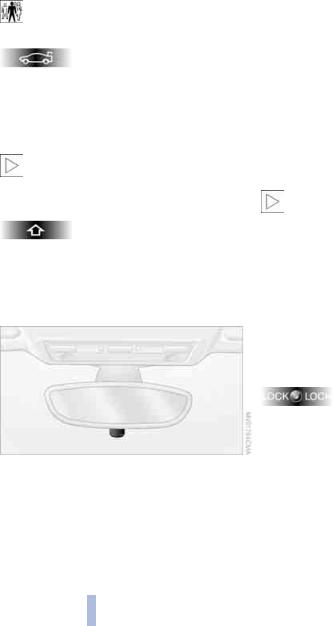
Opening and closing
Arming and disarming the alarm system
When the vehicle is locked or unlocked either via the driver's door lock or with the remote control, the alarm system is simultaneously armed or disarmed.
The hazard warning flashers blink once when the alarm system has been properly armed.
You can have different acknowledgment signals set to confirm arming
and disarming.<
You can still open the luggage compartment lid when the system is armed by pressing the remote control button, refer to page 17. When it is closed, the lid is once again secured.
Manual operation of the luggage compartment lid triggers the alarm.
Refer to page 19.<
To cancel an alarm:
alert, the remaining areas are secured and the indicator lamp flashes continuously after 10 seconds.
However, the interior motion sensor is not activated
>If the indicator lamp goes out as soon as the system is disarmed:
No manipulation or attempted intrusions have been detected in the period since the system was armed
>If the indicator lamp flashes for
10 seconds when the system is being disarmed:
An attempted entry has been detected in the period since the system was armed.
After an alarm has been triggered, the indicator lamp will flash continuously.
Interior motion sensor*
The system monitors the footwells and the seating areas of the driver and passenger.
Deactivate the interior motion sensor, refer to Avoiding unintentional alarms,
if children or animals are to remain in the vehicle.<
Press the button on the remote control, |
Avoiding unintentional alarms |
|
refer to page 16, or turn the ignition key to |
||
The tilt alarm sensor and interior motion |
||
position 1. Refer to page 36. |
||
|
sensor can be deactivated at the same |
|
Indicator lamp displays |
time. You can do this to prevent a false |
|
|
alarm from being triggered, for instance in |
|
|
garages with elevator ramps or when the |
|
|
vehicle is transported by train. |
|
|
Lock the vehicle twice = arm the system: |
|
|
Press the button on the remote control |
|
|
twice in succession, |
|
|
or |
|
> The indicator lamp beneath the interior |
lock the vehicle twice with the key. Refer to |
|
mirror flashes continuously: |
||
page 18. |
||
The system is armed |
||
The indicator lamp lights up briefly and |
||
> The indicator lamp flashes when it is |
||
then flashes continuously. The tilt alarm |
||
being armed: |
||
sensor and the interior motion sensor are |
||
A door, the hood or luggage compart- |
||
deactivated as long as the system is |
||
ment lid is not completely closed. Even |
||
armed. |
||
if you do not close the area causing the |
||
|
26
Online Version for Part No. 01 41 0 157 498 - © 10/03 BMW AG

Adjustments
Safe seating position
For relaxed driving with as little fatigue as possible, you should select a seating position that reflects your personal requirements. In combination with the safety belts and airbags, the correct seating position also plays an important role in enhancing occupant safety in the event of an accident. To ensure that the vehicle's safety systems provide you with optimal protection, we request that you direct your careful attention to the following section.
For supplementary information on transporting children refer to page 33.
Sitting safely with airbags
Always maintain an adequate distance between yourself and the air-
bags. Always hold the steering wheel by its rim with hands at the 9 and 3 o'clock positions to minimize the risk of injuries to your hands or arms in the event of airbag deployment.
Never allow any objects, individuals or animals to obstruct the areas between passengers and airbags.
Never use the front airbag's cover as a storage tray or support for objects of any kind. Ensure that the passenger is correctly seated, i.e. that no feet or legs are propped against the dashboard. Otherwise, leg injury could result if the knee airbag and front airbag suddenly deployed.
Never let an occupant's head rest near or on a side airbag because the inflating airbag could cause a serious or fatal injury.<
Even when all these guidelines are observed, the risk of injury as a result of contact with the airbags cannot entirely be ruled out in some situations. In sensitive individuals, the ignition and inflation noise may induce a mild hearing loss that is temporary in most cases.
For airbag locations and additional information on airbags, refer to page 56.
Sitting safely with safety belts
Always fasten your safety belt before starting off. As supplemental restraint devices, the airbags are designed to enhance the effectiveness of the safety belts, and not to replace them.
Your vehicle offers two sitting positions, each of which is equipped with a safety belt.
At all times, occupants should sit upright and be properly restrained –
infants and small children in appropriate child-restraint systems; larger children and adults using the safety belts.
Expectant mothers should always wear their safety belts, taking care to position the lap belt against the lower hips, where it will not exert pressure against the abdominal area.
Never allow more than one person to wear a single safety belt. Never allow infants or small children to ride in a passenger's lap. Do not route the belt across your neck, or run it across sharp edges. Be sure that the belt does not become caught or jammed. Avoid twisting the belt while routing it firmly across the hips and shoulder; wear it as snugly against your body as possible. Do not allow the belt to rest against hard or fragile objects. Otherwise, the lap belt could slide over the hips in the event of a frontal impact, leading to abdominal injury. Avoid wearing bulky clothing and pull on the lap belt periodically to retension it over your shoulders. Otherwise, the restraining effect of the safety belt could be diminished.<
For information on using the safety belts, refer to page 30.
27
Online Version for Part No. 01 41 0 157 498 - © 10/03 BMW AG
At a glance
Controls
Driving tips
Mobility
Reference
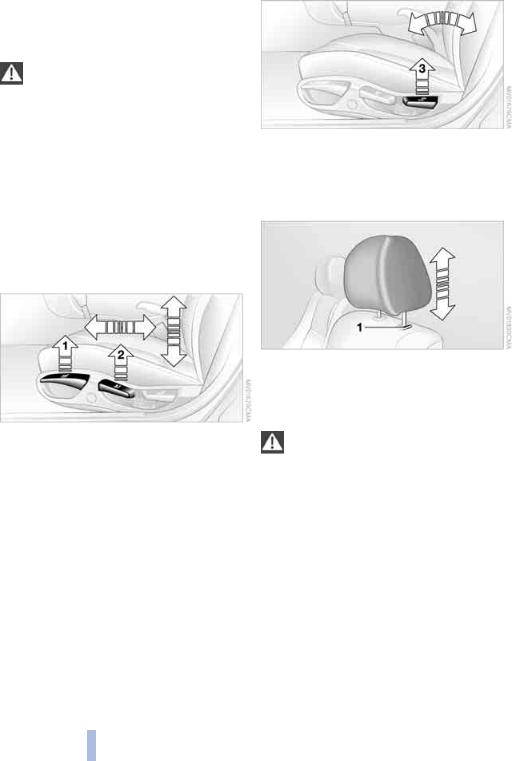
Adjustments
Seats
Before adjusting your seat, always observe the following precautions
Never try to adjust your seat while operating the vehicle. The seat could
respond with an unexpected movement, and the ensuing loss of vehicle control could result in an accident.
Never ride with the backrest inclined to an extreme angle – this also applies to the passenger seat. If you do so, there is a risk that you will slide under the safety belt in the event of an accident, thus reducing the protection provided by the safety belt.<
In addition, observe the instructions regarding damaged safety belts on page 30.
Seat adjustment
1 Backward/forward
Pull lever 1 and slide the seat into the desired position.
After releasing the lever, move the seat backwards or forwards slightly to ensure that the latch engages securely
2 Height
Pull lever 2 and apply weight to or remove weight from the seat as required
3 Backrest
Pull lever 3 and apply weight to or remove weight from the backrest as required.
Head restraints
Adjustments
Height: pull or push.
In order to move to the lowest positions, press button 1.
Adjust the head restraint so that its center is approximately at the height
of your ears. Otherwise, there is a higher risk of injury to the cervical vertebra in the event of an accident.<
Removal
Pull the head restraint upward until it stops.
Press button 1 and remove the head restraint.
Installation
Insert the head restraint into the guides.
28
Online Version for Part No. 01 41 0 157 498 - © 10/03 BMW AG
